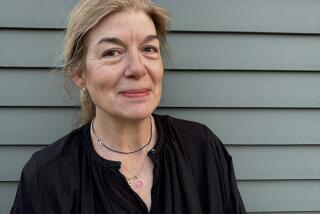BOOK REVIEW: FICTION : An Elegant and Literate Tale of Suspense : THE SEVIGNE LETTERS <i> by William Eisner</i> ; Baskerville $18, 191 pages
- Share via
The engaging narrator of this worldly novel is Franklin Reeber, a young American who has fled a failed marriage and a humdrum engineering career to reinvent himself as a novelist. The time is the early 1950s, the setting is Paris, and Reeber’s new start in life is financed by the GI Bill, which rewarded World War II veterans with an allowance enabling them to continue their education wherever they chose.
Reeber selected the Sorbonne, and when we meet him he’s ensconced in a room in the apartment of Madame Colmar, a charming and intellectual woman of uncertain age who has immediately taken interest in her American tenant. Although most of the novel is written from Reeber’s point of view, passages offer Madame Colmar’s impressions, heightening the contrast between the sophisticated Frenchwoman and the naive American, an enduring theme familiar to admirers of Henry James and Edith Wharton.
Reeber has never known anyone remotely like his landlady. A direct descendant of the 17th-Century belletrist Madame de Sevigne, Madame Colmar lives with her invalid husband. For some time past, Madame has been consoling and diverting herself with her tenants, who are invariably sensitive young men. The current resident is especially responsive, not objecting when Madame changes his name to Francois; capitulating easily when she seduces him.
After months of increasing intimacy, the consummation of the relationship is surprisingly satisfactory for both parties, despite the difference in ages. With the consummation comes an extraordinary confidence. Madame has a cache of unpublished De Sevigne correspondence, a treasure that has been in her family for 300 years.
Madame Colmar, however, is virtually estranged from her own daughter, a stolid, unwed provincial dressmaker. She is convinced that Berthe cares nothing for this heritage, and would seize the chance to sell the letters for the first offer. As the affair between the young man and the older woman progresses, she reveals that her life has precisely paralleled that of her notable ancestor in virtually every respect. Madame Colmar identifies so thoroughly with Madame De Sevigne that she has come to believe that she will die at the same age on the same April day, a moment that is rapidly approaching.
The narrator, renamed Francois, finds his life suddenly divided. In the apartment, he is Madame Colmar’s confidant, companion and lover, but outside it, he is continuing his relationship with the French American girl he knew in Boston, the clever but unprincipled Lea, who persuaded him to break with his past and join her in Paris.
Lea and Reeber are in a cafe when they’re joined by a fellow American who says he is a doctor on his way to a meeting in Switzerland. He tells them about cortisone, a new drug for arthritis, legal in Switzerland but kept from French sufferers by an uncaring bureaucracy. Lea agrees to peddle it to French druggists for a commission, which makes Reeber uneasy.
After one brief and unsuccessful foray in this dangerous adventure, he refuses to participate and temporarily loses touch with Lea, who eagerly becomes the doctor’s agent and prospers greatly. When the drug trade has inevitable, dreadful consequences, Lea attempts to persuade Reeber to steal the De Sevigne letters so that she can sell them to escape prosecution. Though he refuses to rob the woman he loves and respects, he does act as Lea’s accomplice, an act that will haunt him for the rest of his life.
Convinced she is about to die, Madame Colmar wills the letters to Reeber, but they have already vanished with Lea. Unable to finish his novel, Reeber returns to the United States, where he resumes life as an engineer; remarrying, prospering, but never forgetting his extraordinary Parisian adventure.
Readers who delight in elegant, literate fiction should be enchanted by this deft and suspenseful exploration of cultural differences.
More to Read
Sign up for our Book Club newsletter
Get the latest news, events and more from the Los Angeles Times Book Club, and help us get L.A. reading and talking.
You may occasionally receive promotional content from the Los Angeles Times.










